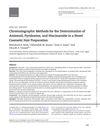 58 citations
,
January 2020 in “International Journal of Molecular Sciences”
58 citations
,
January 2020 in “International Journal of Molecular Sciences” Different methods of preparing Platelet-Rich Plasma (PRP) can affect wound healing and hair regrowth in plastic surgery. Using a kit with specific standards helps isolate PRP that meets quality criteria. Non-Activated PRP and Activated PRP have varying effects depending on the tissue and condition treated. For hair regrowth, Non-Activated PRP increased hair density more than Activated PRP. Both treatments improved various aspects of scalp health.
124 citations
,
November 2019 in “International Journal of Molecular Sciences” Standardized kits improve the quality and consistency of isolating stem cells from fat tissue.
 12 citations
,
February 2014 in “Recent Patents on Inflammation & Allergy Drug Discovery”
12 citations
,
February 2014 in “Recent Patents on Inflammation & Allergy Drug Discovery” Shampoos have evolved into multifunctional products with patented innovations for different hair needs and can include medicinal herbs for hair and scalp health.
 1 citations
,
June 2020 in “Journal of AOAC INTERNATIONAL”
1 citations
,
June 2020 in “Journal of AOAC INTERNATIONAL” Two new methods accurately measure Aminexil, Pyridoxine, and Niacinamide in hair products.
 14 citations
,
July 2021 in “Biomedicines”
14 citations
,
July 2021 in “Biomedicines” Platelet-rich treatments can help improve wound healing and tissue repair.



